Catholic Customs
 |
 |
 |
 |
 |
 |
 |
The Feast of St. Thomas: Lively
& Manly Customs
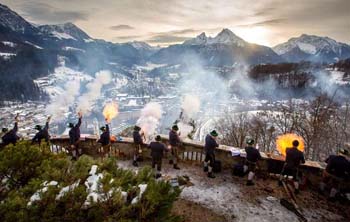
German men shooting in the Alps to scare away demons & salute Christmas
The last days of Advent were always adorned with charming customs as Catholics strove to dispel evil and practice charity in preparation for Christmas.
In parts of central Europe, it was traditional for the men to perform certain vigorous ceremonies to drive away the demons before Christmas. It was common belief that spirits and demons prowled the earth in greater numbers on these nights because the darkness was at its height.
To dispel the demons, men would go into the mountains cracking whips, shooting guns, ringing hand bells and parading with grotesque masks on the days before and after Christmas. In German countries, these nights were called Rauhnächte (Rough Nights). The most important nights for these practices were Thomas Night (December 21), Christmas Eve, New Year's Eve and Epiphany.
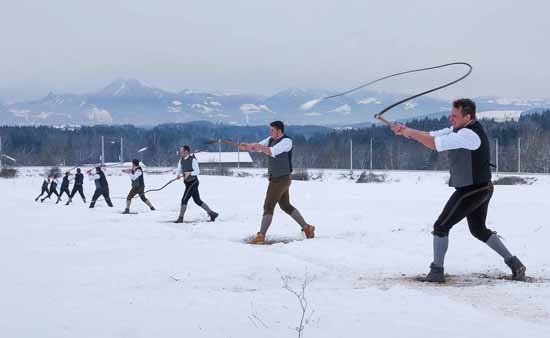
‘Whipcrackers’ drive away demons in the region of Berchtesgadener Land
As the men blessed the home property, the women and the rest of the household gathered by the family altar saying a Rosary for Heavenly aid in that undertaking.
England Thomasing
In England on St. Thomas's Day, it was customary for poor women to go “Thomasing” or “gooding” at the houses of their wealthier neighbors. These poor women, often donning red cloaks, begged in the name of St. Thomas for food (especially wheat for frumenty and flour for Yule bread) and alms to be able to celebrate the coming festival of Christmas in a fitting manner. Many of the recipients of alms would give their benefactors sprigs of holly or mistletoe. In a spirit of hospitality, the benefactors would often invite the poor into their home to give them spiced wine.
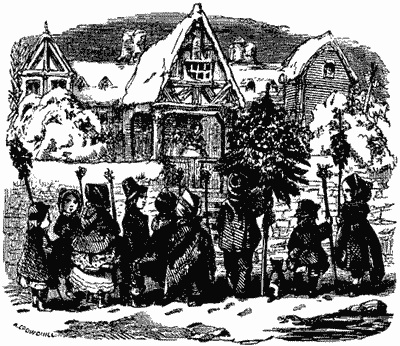
English ladies go ‘Thomasing’
Well-a-ay, well-a-day, St. Thomas goes too soon away;
Then your gooding we do pray, for the good time will not stay.
The longest night & the shortest day!
Please remember St. Thomas's Day!
In Finland, it was traditional to clean the house on Thomas's Day. While the washing was being done, the village blacksmith, priest and locksmith went to each house asking for alms to recompense their labors. The men were always well received, given food and drink in addition to money.
The search for an inn
A popular custom was to have people imitate Our Lady and St. Joseph searching for an inn on each of the nine nights before Christmas. In central Europe, this custom was known as “Herbergsuchen” (“Search for an Inn”) and in Mexico it was known as “Posada” (Inn).
In Mexico and some regions in the United States, the custom of Las Posadas takes place on the nine nights before Christmas. A girl is chosen to ride a donkey dressed as Our Lady and a boy plays St. Joseph; sometimes an angel, shepherds and the Three Wise Men accompany them.
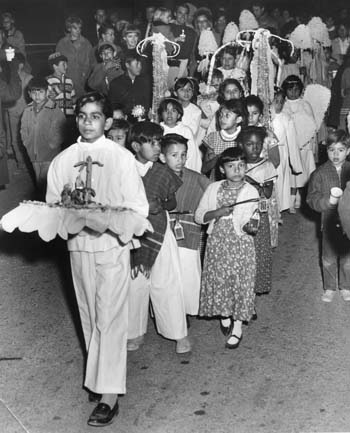
Posadas in Tucson in the 1960s
Finally, after stops at multiple houses, the last home welcomes the Holy Family, along with the whole neighborhood, to pray the Christmas Novena and Rosary and enjoy a fine repast of good Mexican food and drinks.
On the last evening (Christmas Eve), the procession is at its grandest with two new children being added to act as the godparents of Our Lord. When the procession knocks at the door of the final house, the door is opened to reveal a nativity scene into which the godparents place an effigy of the Christ Child. At this grand final arrival of Christmas night, the Mexicans display their joy with fireworks, piñatas and other festivities followed by Midnight Mass.
In Austria, Herbergsuchen was accompanied by ancient Advent carols and the song, “Wer Klopfet an.” This charming and popular song is played and sung, with St. Joseph and Our Lady going to various inns and being refused by cold innkeepers.
In German Alpine regions and parts of Hungary, families would pass an image of Our Lady – specially blessed by the parish priest on the First Sunday of Advent – from one home to the next on each of the nine nights. The family honored by hosting the image for the day would adorn it with candles, and in an evening ceremony they gathered round her to sing and honor Our Lady as the expectant Mother (A favorite hymn was “Maria, die schönste Schäferin”.

A family in the Alps returns home after delivering the holy image to a neighbors
The family who received the image invited the visiting family inside to have drinks and refreshment before the fire. Warmed with good cheer and victuals, the visiting family would traverse the snowy paths back to their home. The last family who received the image or statue would process to the church on Christmas Eve to return the image to its proper place.
In some areas, the image would continue to move from house to house throughout the whole Christmas season until Candlemas, since every family wanted the honor of welcoming the Holy Family to their home.
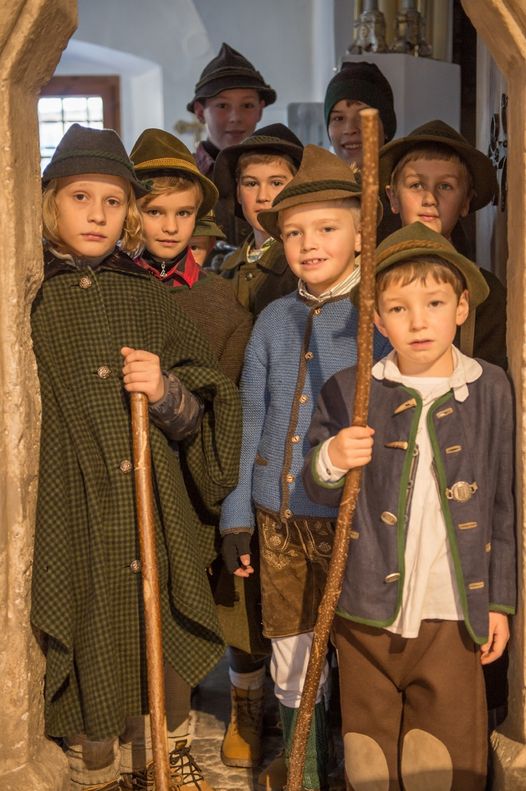
Anlocken boys
Then, the boys would process through the town with the statue accompanied by nine girls dressed in white. The procession would end in the church where the statue would be placed in his special place in the Creche.
In Austria and Franconia the custom of Anklöckeln (Knocking) was practiced on the three Thursdays before Christmas. Children or men dressed as shepherds and paraded from house to house. singing Advent carols (especially “Gott griaß enk, Leitln”), playing the flute, and reciting poems to spread the good news of the approaching feast. The children were rewarded with food and drink or some other gift.
In parts of England during the week before Christmas, the poor women of the village would process with “Advent Images” (two dolls representing Our Lady and the Christ Child) to every house, begging for a halfpenny. They sang a beautiful carol about the seven joys of Mary as they processed.
In Yorkshire, the women carried only one “image” of the Christ Child in a box adorned with evergreens and flowers. Every household who gave an alms to these women was allowed to take one flower or piece of greenery from the box, which was believed to cure toothaches.
All over England it was considered a terrible affront to refuse a penny to the bearers of the “Advent Images.” It was also seen as a great misfortune to miss being visited by these holy images. (Book of Days)
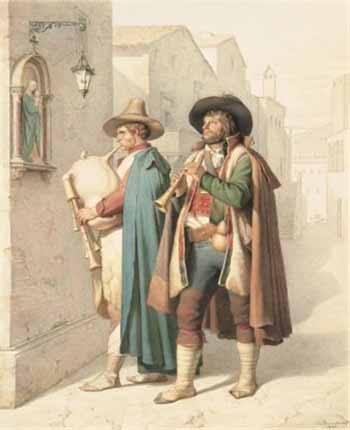
Pifferari play before Our Lady to ease her expectation
In Castelbuono, Italy, people dressed as shepherds and the Holy Family and went from house to house on these nine nights singing the traditional song, Viaggiu Dulurusu. In Marianopoli, local men walked through the streets playing traditional lullabies, ninnaredda, to herald the imminent coming of the Christ Child.
The pifferari (bagpipe-players) came down from the Italian mountain regions into the cities of Naples and Rome during these nights. These men would play sweet music on their pipes through the streets of the cities stopping before images of Our Lady to soothe her in her expectation of the birth of her Son and before carpenter shops to honor St. Joseph. (Curiosities of Popular Customs…)
Restoring the customs
The custom of Herbergsuchen or Posadas can be restored even if merely within the immediate family or household. Every night beginning on December 17, the family – dressed for the parts – can process around the house carrying a statue of Our Lady or image of the Holy Family and singing traditional Advent carols.
Each night the procession can end at a different family member's room where the image can be placed on an altar prepared for it. The person receiving the Holy Image should do so with devotion and seriousness, striving to give due reparation to the Holy Family for the refusal of the inn keepers.
These age old customs seem to fulfill well the supplication of Dom Gueranger: "Let us enter into the spirit of the Church; let us reflect on the great Day which is coming; that thus we may take our share in these the last and most earnest solicitations of the Church imploring her Spouse to come, and to which He at length yields.” (Liturgical Year, vol. 1, p. 484)
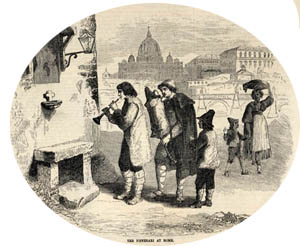
Italian sheeperds serenading Our Lady

Posted December 21, 2020
______________________
______________________
 |
 |
 |
 |
 |
 |


